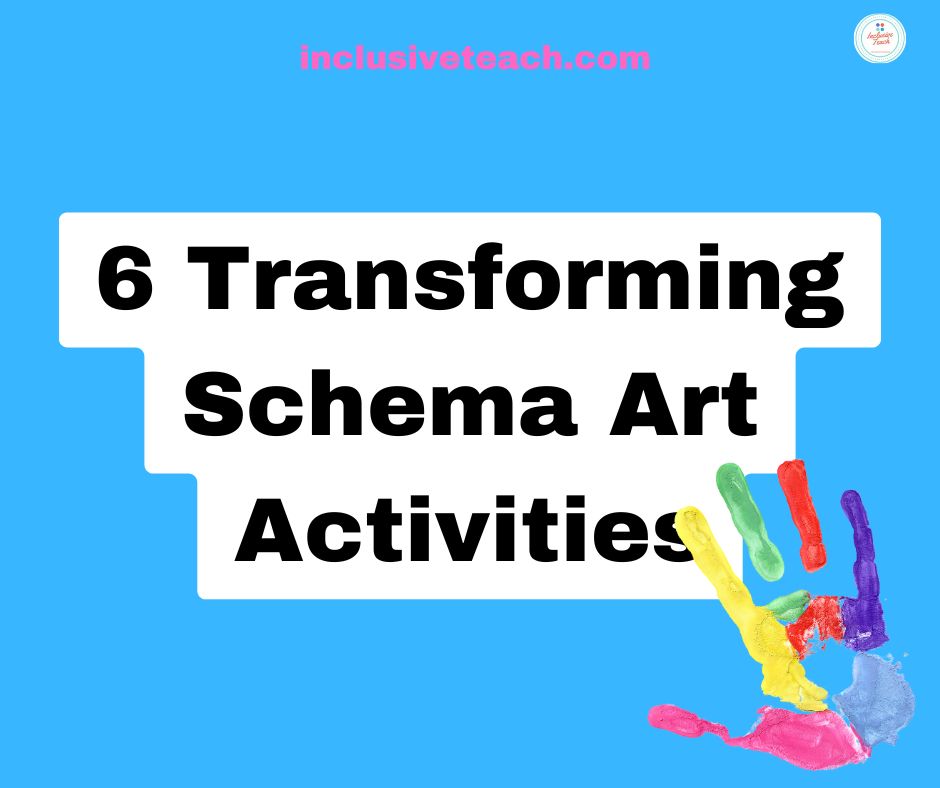
6 Transforming Schema Art Activities
Supporting the Transforming Schema Through Art
As early years practitioners, we often encounter children who seem magnetically drawn to mixing, squishing, and transforming materials. These little scientists are exploring what we call the transforming schema, and art activities provide the perfect laboratory for this crucial developmental work.
I’ve discovered that children with a strong transforming schema aren’t just “making mess” when they combine every paint colour on the palette. They’re conducting serious research into how materials change, and we can harness this natural curiosity through thoughtfully planned creative experiences. Transforming Schema does not involve Optimus Prime it is one of the key play schema used in child development.
Colour Mixing Art Activities for Transforming Schema
Pipette Colour Mixing Activity
Step 1: Setup – Arrange clear containers with primary coloured water (red, blue, yellow) and provide pipettes or droppers. Place on a light table if available for enhanced visual impact.
Step 2: Exploration – Children use pipettes to drop different colours into empty containers, observing how colours blend and transform. Encourage predictions: “What do you think will happen when we mix red and blue?”
Step 3: Documentation – Take photos of colour transformations and create a colour mixing chart together, reinforcing the transformation process and building scientific vocabulary.
This transforming schema activity develops fine motor skills through pipette control while demonstrating cause-and-effect relationships in colour theory.
Cellophane Layering Art Experience
Step 1: Preparation – Provide large sheets of coloured cellophane (primary colours work best) and a light source or window.
Step 2: Investigation – Children layer cellophane sheets, watching new colours emerge through overlapping. They can create patterns, shapes, or abstract designs while discovering colour transformation principles.
Step 3: Extension – Encourage children to trace the new colours they’ve created or use them as inspiration for paintings, connecting the transforming schema to mark-making activities.

Creative Transformation Art Projects
Handprint Transformation Activity
Step 1: Materials – Set up washable paint stations with primary and secondary colours, large paper, and wet wipes for cleanup.
Step 2: Process – Children dip hands in paint and press onto paper, then use fingers or brushes to transform the handprint into animals, flowers, or abstract art, observing how the basic shape changes.
Step 3: Reflection – Discuss the transformation from hand to handprint to creative image, reinforcing the transforming schema while building descriptive language skills.

Hapa Zome Flower Printing Art
Step 1: Collection – Take children on a nature walk to collect fresh flowers and petals (ensure plants are safe and permission is granted).
Step 2: Printing Process – Place petals on fabric, cover with paper, and hammer gently to release natural dyes. Children observe how plant materials transform into permanent coloured marks.
Step 3: Analysis – Compare different flowers’ results, discussing why some create stronger colours than others, supporting scientific thinking within the transforming schema.

Butterfly Squish Painting Technique
Step 1: Setup – Fold paper in half, then open. Place paint blobs on one side using different colours and varying amounts.
Step 2: Transformation – Children fold paper again and press, squish, and rub to spread paint. The anticipation builds as they wonder what patterns will emerge.
Step 3: Reveal – Open paper to reveal symmetrical designs. Discuss pattern, symmetry, and colour mixing, connecting art to mathematical concepts while satisfying the transforming schema.
Pattern Discovery Through Art Activities
Texture Rubbing Art Activity
Step 1: Surface Selection – Provide various textured surfaces (tree bark, coins, textured fabric, leaves) and thin paper with crayons or pencils.
Step 2: Rubbing Technique – Children place paper over textures and rub with crayons to reveal hidden patterns. Encourage experimentation with different pressures and directions.
Step 3: Pattern Analysis – Compare rubbings, discuss patterns created, and use mathematical language (lines, shapes, repetition) to describe transformations from invisible to visible textures.
Open-Ended Mark-Making for Schema Development
Multi-Tool Mark Making Experience
Step 1: Tool Collection – Gather unconventional mark-making tools: sticks, sponges, cotton buds, toy cars, kitchen utensils alongside traditional brushes and crayons.
Step 2: Surface Variety – Offer different surfaces for transformation: paper, cardboard, clay, sand trays, or outdoor concrete areas, allowing children to discover how tools create different effects.
Step 3: Process Documentation – Photograph children’s mark-making processes and final transformations, creating a visual record of their transforming schema exploration and artistic development.
Supporting The Transforming Schema
In my experience, children exploring the transforming schema need us to see beyond the mess to the meaningful learning underneath. They’re developing scientific thinking, cause-and-effect understanding, and creative problem-solving skills. By providing rich opportunities for transformation through art, we’re not just keeping them busy – we’re supporting fundamental cognitive development.
The key is trusting the process, embracing the mess, and recognizing that when children are deeply engaged in transforming materials, they’re doing exactly what they need to do to grow and learn.

Related
Discover more from Special Education and Inclusive Learning
Subscribe to get the latest posts sent to your email.
Source link



